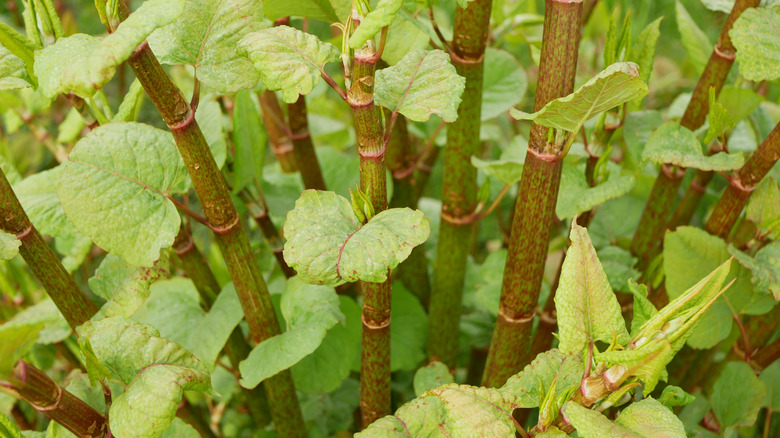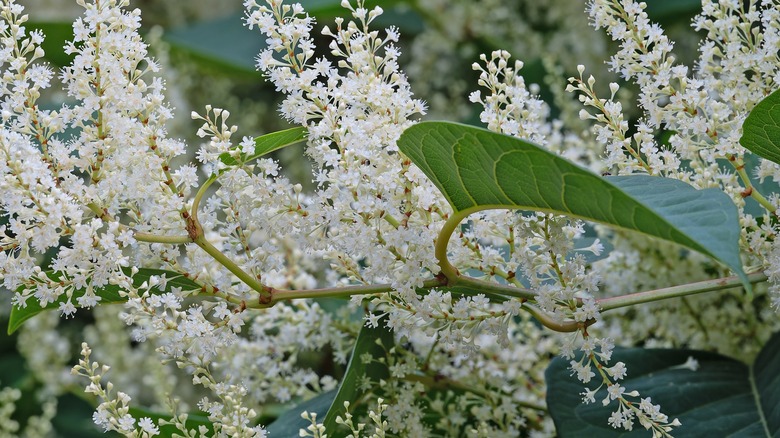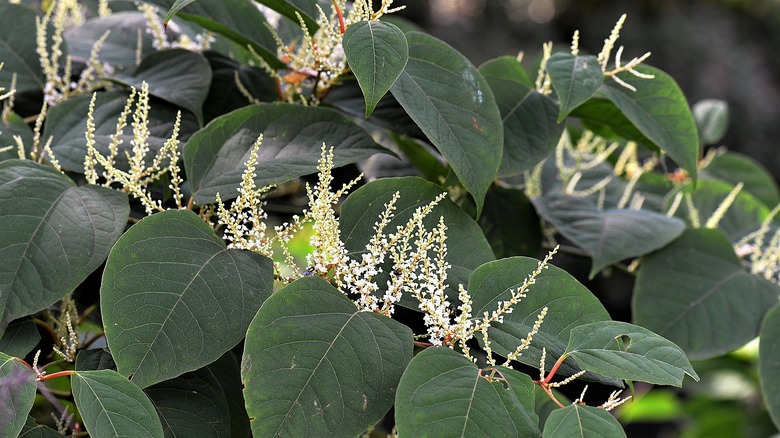A Gardening Expert Explains How To Keep Japanese Knotweed Out Of Your Garden
As beautiful as Japanese knotweed may appear to the unknowing eye, it doesn't take gardeners long to discover that beauty to be deceiving — because the same flowering shrub that's commonly planted and used as a staple in landscaping is also noted by the U.S. National Park Service to be one of the most invasive plants in the world. To learn more about Japanese knotweed, House Digest spoke exclusively with Liz Will, master gardener, garden coach, and educator at Learn To Grow Gardens, who gave us a rundown on this perennial plant and how to rid your garden of it once and for all.
"Originally, it was used as an ornamental plant on estates, but was quickly found to be problematic," Will told House Digest, adding that the invasive perennial was initially brought over from Eastern Asia in the late 1800s. "It grows as a shrub, with broad, green leaves that taper at the ends. It has white flowers that bloom in panicle clusters from August to September. It's a very pretty plant, and not hard to see why it was originally used as an ornamental."
Despite its ornamental appeal, however, Will notes that because it grows well in sun, shade, and even drought, knotweed spreads extremely quickly in a way that's not easily controlled, causing it to completely overtake wherever it lays root, potentially killing off native species. "It can also cause damage to buildings, by growing through cracks and weak points," she said.
How to identify and prevent Japanese knotweed
To prevent Japanese knotwood from entering your garden, Liz Will says to keep an eye out for signs of new growth in the areas surrounding your property. "Young growth resembles asparagus or bamboo shoots that are red in color," she explained to House Digest in an exclusive interview, adding, "Later, the shoots become hollow stems." Will notes that when fully grown, the "bamboo-like stems" of Japanese knotweed can grow to be 10 to 15 feet tall. For this reason, it's often referred to as Japanese bamboo.
"Typically, it can be found around old homes and farms, in areas that have been disturbed, such as for road construction, and along rivers and streams," Will said. "It spreads both through rhizomes, and fragments of roots and stems that are dispersed when land is disturbed."
That's why identifying Japanese knotweed and being able to prevent it from encroaching on your property is so important, as getting rid of it isn't as simple as digging up the plants or cutting them back. According to Will, "Attempting to dig up the plant can make the problem worse, as any pieces of the rhizome or stems left behind will sprout into a new plant."
While trimming back Japanese knotweed is effective at temporarily keeping new growth under control, it's not an effective long-term solution — and though digging up the plant can help to slow growth, unless you're careful to remove every piece, it's sure to grow back just as quickly. This makes fully, and permanently eliminating knotweed from your property very difficult.
How to remove Japanese knotweed
If Japanese knotweed does make its way into your garden, master gardener Liz Will tells us that it's important to have patience when trying to get rid of it, noting that it may take several years to fully eradicate the plant once it lays root.
While Japanese knotweed can survive in the shade, Will noted that because it grows strongest in full sun, completely shielding it from the sun can slow its growth. "Covering the area with a tarp in the spring can help control a small area," she exclusively told House Digest. "Cut the stems to the ground and hold the tarp down with rocks. Leave the tarp in place until you are sure it has withered and died. This can take an entire season, or more, depending on the size and strength of the plant."
Instead of trying to dig up or cut down the plant, Will says your best bet is simply using a weed killer, such as glyphosate. "It's best to apply it in spring and fall, using extreme caution and following the directions on the label," she added. Further, if your Japanese knotweed problem has grown too large for you to manage on your own, Will recommends hiring a professional to come take care of it for you.


